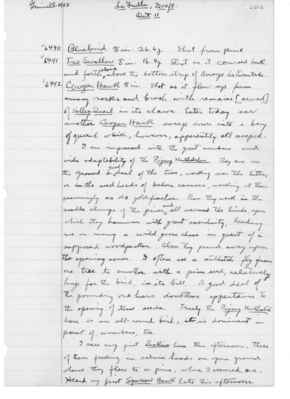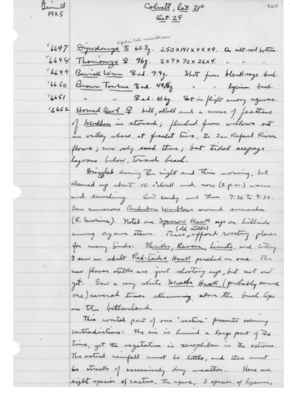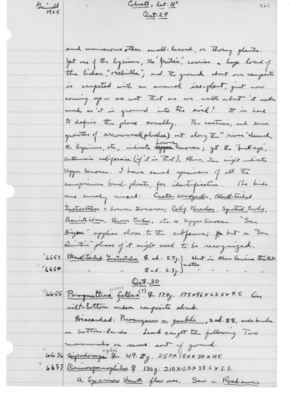Pages That Mention sparrow Hawk
1925: Joseph Grinnell's field notes
S3 Page 39
Collector: Grinnell - 1925 Location: La Grulla, 7200 ft. Date: Oct. 11 Page Number: 2582 6490 Bluebird (male sign) im. 26.6g. Shot from pine. 6491 Tree Swallow (male sign) im. 16.4g. Shot as it coursed back and forth alone above the bottom strip of Arroyo La Encantada. 6492 Cooper Hawk. (male sign) im. Shot as it flew up from among rocks and brush with remains [saved] of Valley Quail in its claws. Later today saw another Cooper Hawk sweep down into a bevy of quail which, however, apparently all escaped. I am impressed with the great numbers and wide adaptability of the Pigmy Nuthatches. They are on the ground a good deal of the time, working over the litter; or in the seed heads of Salvia carnosa, working at them seemingly as do goldfinches. Then they work in the needle clumps of the pines, and all around the limbs upon which they hammer with great assiduity, leading me on many a wild goose chase in quest of a supposed woodpecker. Also they pound away upon the opening cones. I often see a nuthatch fly from one tree to another with a pine seed, relatively huge for the bird, in its bill. A good deal of the pounding one hears doubtless appertains to the opening of these seeds. Truly the Pigmy Nuthatch here is an all-round bird; it is dominant in point of numbers, too. I saw my first Siskins here this afternoon, three of them feeding in salvia heads on open ground whence they flew to a pine, where I secured one. Heard my first Sparrow Hawk late this afternoon.
S3 Page 68
Collector: Grinnell - 1925 Location: Colnett, Sat. 31 degrees Date: October 29, 1925 Page Number: 2610
6647 Dipodomys (male sign) 60.3g. 250 x 141 x 42 x 9. On silt-soil bottom. 6648 Thomomys (female sign) 96g. 207 x 70 x 26 x 4. “ “ “ 6649 Bewick Wren (female sign) ad. 9.9g. Shot from black-sage bush. 6650 Brown Towhee (male sign) ad. 44.5g “ “ lycium bush. 6651 “ “ (female sign) ad. 41.6g. Shot in flight among agaves. 6652 Horned Owl (female sign) bill, skull and a mass of feathers of Mudhen in stomach; flushed from willows out in valley where, at freshet time, the San Rafael River flows; now only sand there; but tidal seepage lagoons below, toward beach.
Drizzled during the night and this morning, but cleared up about 10 o’clock and now (2 p.m.) warm and sunshiny. Out early and then 7:30 to 9:30. Saw numerous Audubon Warblers around sumachs (R. laurina). Noted one Sparrow Hawk up on hillside among agave stems. These (old stalks) afford roosting places for many birds: Shrikes Ravens, Linnets, and today I saw an adult Red-Tailed Hawk perched on one. The new flower stalks are just shooting up, but not out yet. Saw a very white Marsh Hawk (probably same one) several times skimming above the bush tops on the bottomland. The coastal part of our “section” presents seeming contradictions: the air is humid a large part of the time, yet the vegetation is xerophilous in the extreme. The actual rainfall must be little, and there must be streaks of excessively dry weather. Here are eight species of cactus, the agave, 3 species of lycium,
S3 Page 69
Collector: Grinnell - 1925 Location: Colnett, lat. 31 degrees Date: October 29, 1925 Page Number: 2611
and numerous other small-leaved, or thorny plants. Yet one of the lyciums, the “frutéa,” carries a huge load of the lichen, “orchilla”; and the ground about hour campsite is carpeted with an annual ice-plant, just now coming up - so wet that as we walk about it makes mud as it is ground into the soil! It is hard to define the place zonally. The cactus, and dense growths of arrowweed (pluchea) out along the “river” channel, the lyciums, etc., indicate Lower Sonoran; yet the “buck-eye”, artemisia californica (if it is that), Rhus, etc., might indicate Upper Sonoran. I have saved specimens of all the conspicuous bush plants, for identification. The birds are surely mixed: Cactus Woodpecker, Black-Tailed Gnatcatcher = Lower Sonoran; Calif. Thrasher, Spotted Towhee, Bewick Wren, Brown Towhee, etc. = Upper Sonoran. “San Diegan” applies close to the sub fauna; but a “San Quentin” phase of it might need to be recognized.
6653 Black-Tailed Gnatcatcher (female sign) ad. 5.7g. 6654 “ “ (male sign) ad. 6.3g. Shot in Rhus laurina thickets. mates.
Oct. 30 6655 Perognathus fallax (?) (female sign) 17.4g. 175 x 96 x 23.5 x 4.5 On silt-bottom under composite shrub. Discarded: Peromyscus m. gambeli, 2 ad. (male sign) (male sign), under bushes on bottomlands. Lamb caught the following two mammals on same sort of ground. 6656 Dipodomys agilis (female sign) 49.2g. 257 x 150 x 38 x 115. 6657 Ammospermophilus (female sign) 130g. 210 x 53 x 38.5 x 5.5. A Sparrow Hawk flew over. Saw a Roadrunner


